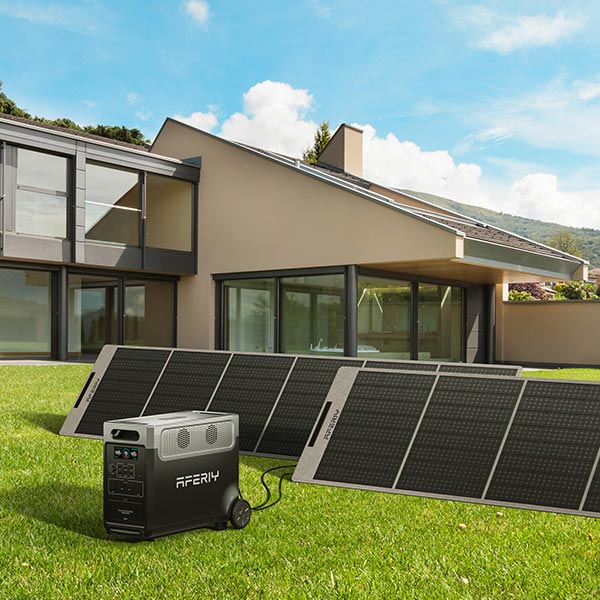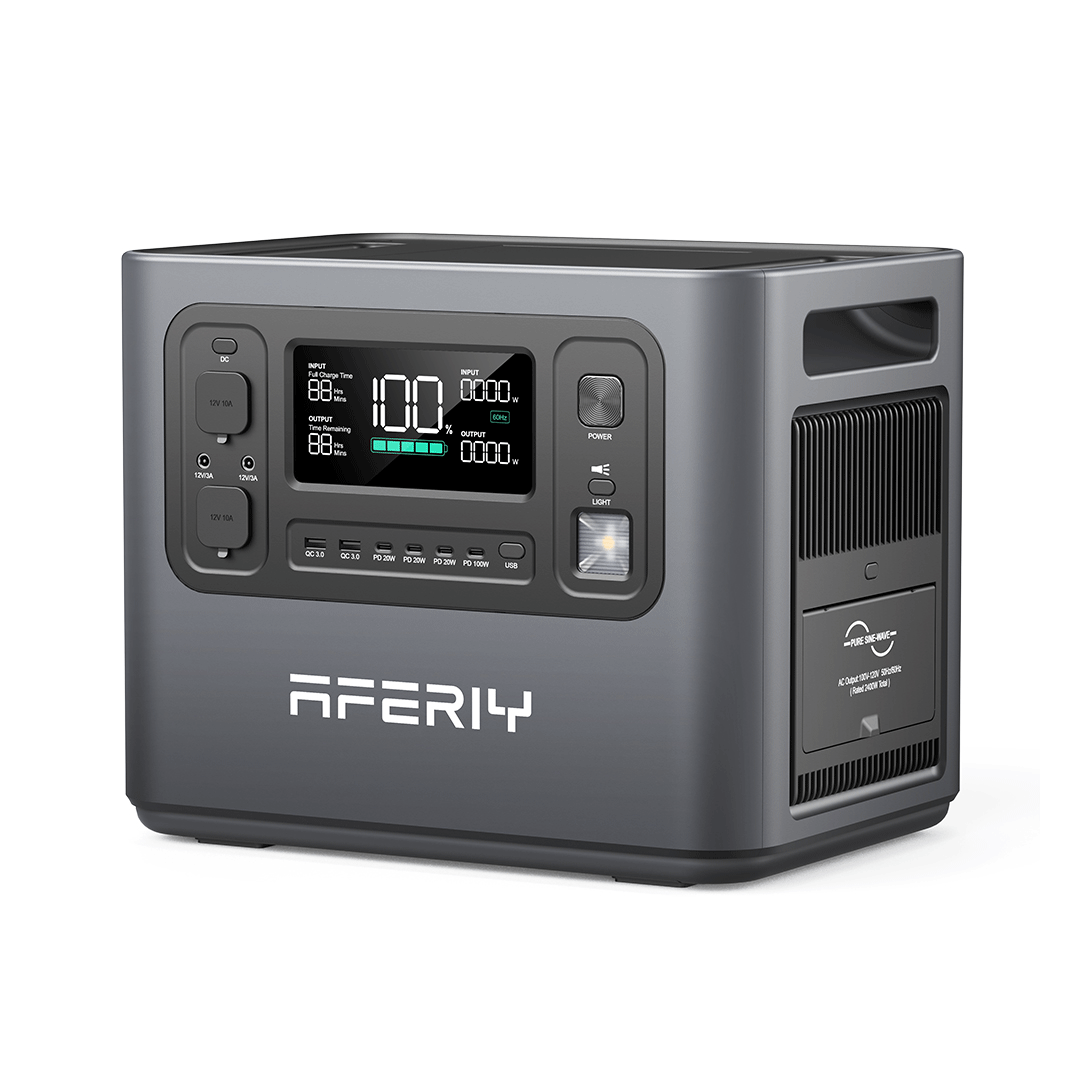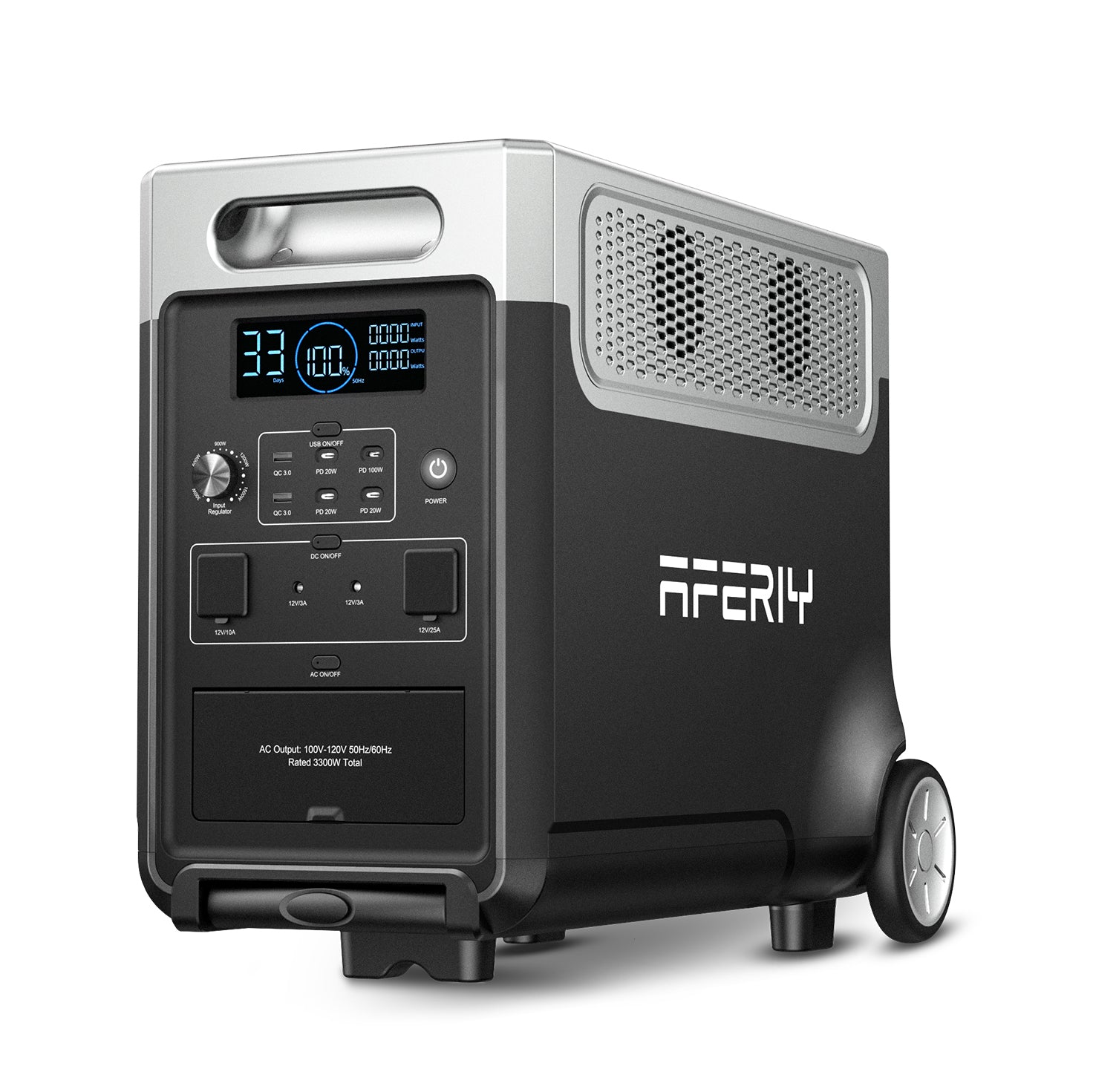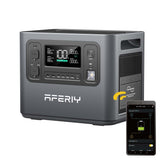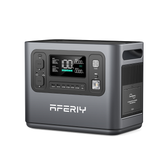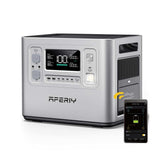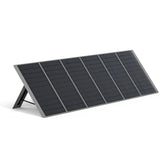-
AFERIY P210 Portable Power Station 2400W 2048Wh2400W AC Pure Sine Wave Inverter; 2048Wh Large Capacity; App Bluetooth Control; Recharge from 0-100% in 2 Hours(AC input); LiFePo4 Battery with 4000+ Life Cycles to 85%; 4 Ways to Recharge (AC/Solar/Car/AC+Solar) 16 Outputs For Multiple Devices; 500W Max MPPT. Solar Input; UPS Battery Backup;
- From $699.00
$999.00- From $699.00
- Unit price
- per
Save $300.00 -
AFERIY P110-D Portable Power Station 1200W 960WhLarge 960Wh Capacity, 1200W High Output Pure Sine Wave AC Output, UPS Mode Safe & Stable LiFePO4 Battery, 3500 Cycles to 85%+ Capacity,Up to 10 Years Battery Life Built in BMS Battery Management System Quick Fully Recharged in 1.5 Hour Power 14 Devices Simultaneously Robust and Long-lasting 7 Year Long Superb Warranty
- $499.00
$899.00- $499.00
- Unit price
- per
Save $400.00 -
AFERIY P310 Portable Power Station with Expandable Capacity 3600W 3840Wh🔔P310-EC-APP Pre-Order Now OpenDue to increased demand, this item is on pre-sale.Est.Shipping Start Date: July 30 2025Thank you for your patience and support! 3600W Pure Sine Wave Output Inverter 3840Wh Capacity (Expandable up to 11520Wh with two additional batteries connected in series) Durable LiFePO₄ Battery, maintaining 80% capacity after 4000+ cycles, lifespan up to 11 years Safe BMS Battery Management System — 24/7 Monitoring Smart Control via App Home UPS Backup Power with 10ms Switchover Time Maximum Solar Input: 2000W (12-160V) Maximum AC Input: 1500W (100V-120V); Adjustable Input Power: 300W/600W/900W/1200W/1500W Fast Charging: Reaches 80% in Just One Hour (AC + Solar Combined) 7 Years Warranty
- From $1,399.00
$2,599.00- From $1,399.00
- Unit price
- per
Save $1,200.00 -
AFERIY P010 Portable Power Station 800W 512Wh512Wh Capacity, 800W High Output Pure Sine Wave AC Output, UPS Mode LiFePO4 Battery, 3500 Cycles to 85%+ Capacity,Up to 10 Years Battery Life Safe BMS Battery Management System Fast Charge from 0%-100% within 1 Hour Power 8 Devices Simultaneously Lightweight and Compact, Easy to Carry 7 Year Long Superb Warranty
- $299.00
$599.00- $299.00
- Unit price
- per
Save $300.00 -
AFERIY P210 Portable Power Station 2400W 2048Wh Silver2400W AC Pure Sine Wave Inverter; 2048Wh Large Capacity; App Bluetooth Control; Recharge from 0-100% in 2 Hours(AC input); LiFePo4 Battery with 4000+ Life Cycles to 85%; 4 Ways to Recharge (AC/Solar/Car/AC+Solar) 16 Outputs For Multiple Devices; 500W Max MPPT. Solar Input; UPS Battery Backup;
- From $699.00
$999.00- From $699.00
- Unit price
- per
Save $300.00 -
AFERIY Nano100 Portable Power Station 100W 99.2Wh99.2Wh Capacity (31,000mAh); Maximum Output Power of 145W; Built-in 70cm Retractable 100W USB-C Cable; Simultaneous Charging of up to 3 Devices; Compact Size – Ultra Lightweight (only 1.1 kg); Maximum Solar Input of 100W; LiFePO₄ Battery – Over 2000 Cycles; Battery Management System (BMS) + NTC Temperature Control;
- $69.00
$99.00- $69.00
- Unit price
- per
Save $30.00
Recently Viewed Products
Example product title
- $19.99
- $19.99
- Unit price
- per
Example product title
- $19.99
- $19.99
- Unit price
- per
Example product title
- $19.99
- $19.99
- Unit price
- per
Example product title
- $19.99
- $19.99
- Unit price
- per
Example product title
- $19.99
- $19.99
- Unit price
- per
Example product title
- $19.99
- $19.99
- Unit price
- per
Example product title
- $19.99
- $19.99
- Unit price
- per
Example product title
- $19.99
- $19.99
- Unit price
- per
Example product title
- $19.99
- $19.99
- Unit price
- per
Example product title
- $19.99
- $19.99
- Unit price
- per
FAQs
Are home backup batteries safe?
Yes, home backup batteries are generally very safe when installed and used correctly. Modern home backup batteries are built with multiple safety mechanisms, such as temperature control, overcharge protection, short circuit protection, and fire-resistant housing. These features reduce the risk of overheating or fire. Most reputable home backup batteries also undergo rigorous testing and carry safety certifications like UL or CE.
Proper installation is key to safety. Always have your home backup battery installed by a licensed professional, especially when integrating with your home's electrical system. Avoid placing it in humid or overly hot environments, and follow maintenance guidelines provided by the manufacturer. In short, when you choose a quality product and use it properly, home backup batteries offer reliable and safe power storage for emergencies and daily backup needs.
Proper installation is key to safety. Always have your home backup battery installed by a licensed professional, especially when integrating with your home's electrical system. Avoid placing it in humid or overly hot environments, and follow maintenance guidelines provided by the manufacturer. In short, when you choose a quality product and use it properly, home backup batteries offer reliable and safe power storage for emergencies and daily backup needs.
How long can a portable power station power my devices?
The runtime of a portable power station depends on its battery capacity (measured in watt-hours) and the power draw of the devices you're running. For example, a 500Wh portable power station can charge a smartphone about 30 times or run a 60W mini fridge for around 7–8 hours. Larger portable power stations —1,000Wh or more—can handle high-demand appliances like TVs, power tools, or even CPAP machines overnight.
When planning usage, calculate the total wattage of your devices and divide the battery capacity by that number. Keep in mind that portable power stations lose a small percentage of energy through inverter inefficiencies, so they always leave some buffer. Whether for camping, remote work, or emergency backup, a portable power station gives you flexible, quiet, and eco-friendly power—just choose a model that fits your energy needs.
When planning usage, calculate the total wattage of your devices and divide the battery capacity by that number. Keep in mind that portable power stations lose a small percentage of energy through inverter inefficiencies, so they always leave some buffer. Whether for camping, remote work, or emergency backup, a portable power station gives you flexible, quiet, and eco-friendly power—just choose a model that fits your energy needs.
Can I use a portable power station to run a refrigerator?
Yes, many portable power stations can run a refrigerator, especially energy-efficient or compact models. A standard home refrigerator typically uses between 100–800 watts, depending on size and age. To ensure your portable power station can handle the load, check both the running wattage and the surge wattage (startup power spike) of the fridge.
Choose a portable power station with at least 1000Wh of battery capacity and a high enough continuous output (usually 1000W or more). This setup can power a small fridge for 6–12 hours, depending on usage cycles. For a longer runtime, you can combine the portable power station with solar panels to recharge during the day. Using a portable power station for your refrigerator is a practical solution during blackouts, camping, or off-grid living.
Choose a portable power station with at least 1000Wh of battery capacity and a high enough continuous output (usually 1000W or more). This setup can power a small fridge for 6–12 hours, depending on usage cycles. For a longer runtime, you can combine the portable power station with solar panels to recharge during the day. Using a portable power station for your refrigerator is a practical solution during blackouts, camping, or off-grid living.
Can a portable power station be used with solar panels?
Yes, most portable power stations can be recharged using solar panels, making them perfect for off-grid living or eco-friendly backup power. When paired with compatible solar panels, your portable power station becomes a solar generator capable of running essential devices without access to the grid. This is especially useful for camping, emergencies, or RV living.
To use solar charging, check if your portable power station has a solar input port and MPPT controller (for faster, more efficient charging). You’ll also need solar panels with matching voltage and connectors. Recharging time depends on panel wattage and sunlight conditions—100W panels may take 6–10 hours to charge a 500Wh unit. With the right setup, your portable power station can be a clean and renewable energy source wherever you go.
To use solar charging, check if your portable power station has a solar input port and MPPT controller (for faster, more efficient charging). You’ll also need solar panels with matching voltage and connectors. Recharging time depends on panel wattage and sunlight conditions—100W panels may take 6–10 hours to charge a 500Wh unit. With the right setup, your portable power station can be a clean and renewable energy source wherever you go.
Can I use a portable charging station outdoors?
Yes, a portable charging station is great for outdoor use, especially if you enjoy camping, tailgating, hiking, or need backup power on a job site. Many modern portable charging stations are designed with durable casings, ergonomic handles, and compact forms to make them easy to carry anywhere. Some even include IP-rated weather resistance, meaning they can handle light rain, dust, and rough environments.
When choosing a portable charging station for the outdoors, look for features like solar input compatibility, LED lighting, and pass-through charging. These functions allow you to power your devices while recharging the portable charging station in sunlight. Just be cautious—extreme temperatures and water exposure can degrade performance. For best results, keep your portable charging station under shade or shelter when not in use and avoid leaving it in damp conditions overnight.
When choosing a portable charging station for the outdoors, look for features like solar input compatibility, LED lighting, and pass-through charging. These functions allow you to power your devices while recharging the portable charging station in sunlight. Just be cautious—extreme temperatures and water exposure can degrade performance. For best results, keep your portable charging station under shade or shelter when not in use and avoid leaving it in damp conditions overnight.
Do portable charging stations work during power outages?
Absolutely. A portable charging station is a dependable power source during blackouts and emergencies. Because it runs on stored battery energy, a portable charging station can power critical devices like smartphones, Wi-Fi routers, medical equipment, lamps, or even laptops when the grid goes down. Unlike traditional gas generators, a portable charging station is silent, doesn’t produce fumes, and can be used safely indoors.
For longer outages, consider a portable charging station with solar panel compatibility so you can keep it recharged without relying on grid power. This makes it an eco-friendly and reliable energy backup solution. Many households now keep a portable charging station in emergency kits, especially in regions prone to storms, wildfires, or rolling blackouts. Having a portable charging station on hand ensures that your essential devices stay online even when everything else goes dark.
For longer outages, consider a portable charging station with solar panel compatibility so you can keep it recharged without relying on grid power. This makes it an eco-friendly and reliable energy backup solution. Many households now keep a portable charging station in emergency kits, especially in regions prone to storms, wildfires, or rolling blackouts. Having a portable charging station on hand ensures that your essential devices stay online even when everything else goes dark.
Can I install a home backup battery without solar panels?
Yes, you can install a home backup battery without solar panels. While solar integration is common, many home backup batteries are designed to charge from the grid and provide energy during outages. This setup works well for people who want emergency power but don't have the option—or budget—to install solar panels.
A home backup battery stores electricity from your main power supply and can automatically kick in during a blackout. This ensures your lights, appliances, and medical devices stay operational. It's also useful for time-of-use billing programs, allowing you to charge the battery during off-peak hours and use it when electricity is most expensive. In summary, even without solar, a home backup battery is a smart investment for energy security and efficiency.
A home backup battery stores electricity from your main power supply and can automatically kick in during a blackout. This ensures your lights, appliances, and medical devices stay operational. It's also useful for time-of-use billing programs, allowing you to charge the battery during off-peak hours and use it when electricity is most expensive. In summary, even without solar, a home backup battery is a smart investment for energy security and efficiency.
Can I run air conditioning with a backup home battery?
Yes, you can run an air conditioner with a backup home battery , but it depends on the battery’s capacity and the AC unit’s energy demand. Most central air systems require 2000–5000 watts, which can drain smaller backup home batteries quickly. However, window units or portable ACs using 500–1500 watts are more manageable for mid-size battery systems.
To power air conditioning effectively, you’ll need a backup home battery with high output (3000W or more) and large storage capacity (5 kWh or above). Some advanced backup home batteries can even integrate with solar panels to extend runtime during hot days. Though costly, this setup provides comfort and safety during summer blackouts. Be sure to consult an electrician to ensure your backup home battery can support your specific cooling needs.
To power air conditioning effectively, you’ll need a backup home battery with high output (3000W or more) and large storage capacity (5 kWh or above). Some advanced backup home batteries can even integrate with solar panels to extend runtime during hot days. Though costly, this setup provides comfort and safety during summer blackouts. Be sure to consult an electrician to ensure your backup home battery can support your specific cooling needs.
Can I charge a backup home battery during an outage?
Yes, many backup home batteries can be recharged during an outage, especially if they're connected to solar panels or a generator. While charging from the grid is disabled during blackouts for safety reasons, a solar-compatible backup home battery can replenish itself using sunlight, providing ongoing power even if the outage lasts several days.
Some backup home batteries also work with gas or dual-fuel generators, creating a hybrid system that allows for faster recharging. Make sure your system is configured to support off-grid charging and that your solar inverter is designed for blackout operation. With the right setup, a backup home battery offers a flexible and resilient energy solution that keeps your lights on and your fridge running even when the grid is down.
Some backup home batteries also work with gas or dual-fuel generators, creating a hybrid system that allows for faster recharging. Make sure your system is configured to support off-grid charging and that your solar inverter is designed for blackout operation. With the right setup, a backup home battery offers a flexible and resilient energy solution that keeps your lights on and your fridge running even when the grid is down.
Can I charge multiple devices at once with a portable charging station?
Yes, one of the biggest advantages of a portable charging station is its ability to charge multiple devices simultaneously. Most portable charging stations come with several USB-A and USB-C ports, AC outlets, and even DC car ports. This means you can power your phone, tablet, camera, laptop, and even a mini fridge all at once—perfect for camping, road trips, or emergency use at home.
However, be aware of the station’s total output capacity. If the combined wattage of all connected devices exceeds the rated power of your portable charging station, it may shut down or reduce output to protect the system. Higher-end portable charging stations have smart power distribution systems that automatically balance the load, ensuring every device gets what it needs. This versatility is why a portable charging station has become an essential gadget for modern, on-the-go lifestyles.
However, be aware of the station’s total output capacity. If the combined wattage of all connected devices exceeds the rated power of your portable charging station, it may shut down or reduce output to protect the system. Higher-end portable charging stations have smart power distribution systems that automatically balance the load, ensuring every device gets what it needs. This versatility is why a portable charging station has become an essential gadget for modern, on-the-go lifestyles.
- Choosing a selection results in a full page refresh.

